With over a thousand species, wildflower identification is a fun, engaging activity that can be done anywhere in Glacier National Park:
- From high-alpine meadows…
- to the rugged slopes of the Lewis & Clark mountains…
- to the fields and prairies they cascade into.
- From dense forests that envelope the eastern side of the park…
- to the jagged edge of Going to the Sun Road…
No matter where you travel and adventure in Glacier National Park, wildflowers will be your constant companion, so it helps to be adept in wildflower identification and names.
Although the wildflower aficionado might use a wildflower identification guidebook to aid in their wildflower iding, even a tourist on vacation can use this guide to successfully identify Glacier National Park’s wildflowers.
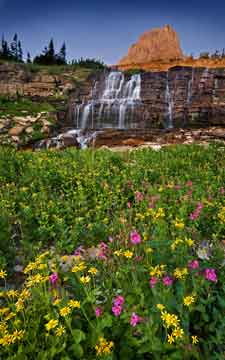 |
|
Photo by |
And regardless what your wildflower knowledge is, you’d have to be color blind not to be
- mesmerized by meadows and prairies dotted in the purple and gold of alpine daisies
- the scarlet red of Indian Paintbrushes
- pink of fireweeds
- sunburst yellow of glacier lilies
- the delicate, pink petals and honey, orange inside of Monkeyflowers…
the beauty and list of wildflowers goes on…
If you are looking for a wildflower identification guidebook, I personally recommend the National Audubon Society Field Guide to North American Wildflowers: Western Region. It has extensive & detailed pictures of every wildflower you could ever find in Glacier National Park.
Identify a Wildflower
Here you will find common wildflower names, a photo gallery, descriptions and the best locations for wildflower identification in Glacier National Park, Montana.
And considering it stimulates your senses of touch, sight, and smell, wildflower identification is a mentally engaging activity that should not be overlooked while on your Glacier National Park vacation.
Beargrass
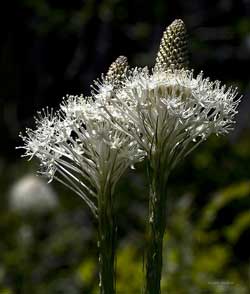 |
|
Photo by |
Just as the park’s name is misleading, so is the name of beargrass. Bears have no use for it, nor is it a grass. It’s one of Glacier National Park’s most recognizable flowers and can grow at a wide-range of elevations.
No matter what trail you hike, beargrass is sure to rise above the real grass and dot the landscape. They are four to five feet in height and are topped off with cream colored bulbs that look like an upside-down vase.
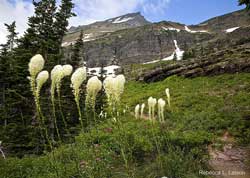 |
|
Photo by |
Interesting Fact: The Blackfeet Indians used to use the hardy leaves of Beargrass to create clothing and baskets.
Bunchberry –
Cornus canadensis
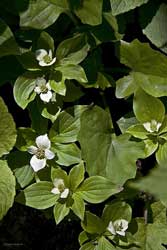 |
Bunchberry is a low rising shrubbery that is easily identifiable by bunches of tiny, four cloved, white flowers. They grow primarily in shaded, forested areas, such as the hills around Bowman Lake.
They are hardy survivors of forest fires and provide food for numerous animals in Glacier National Park, such as moose and grizzly bears.
Interesting fact: The fruit are edible for humans and can even be made into jellies.
Pasque Blossoms
– Pulsatilla patens
These gorgeous, showy flowers are visible in meadows along the eastern slopes of Glacier National Park from late May. They are one of the earliest blooming flowers and their heads can be noticed poking above the snow in altitudes up to 10,000 feet.
How to identify:
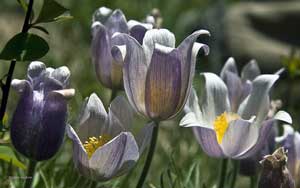 |
- When in full bloom, the blossom has 5 to 7 sepals that look like petals
- Flowers are approximately 1 to 4 inches wide
- Pink, white and lavender tulip-esque blossoms with yellow insides
Interesting fact: Native Americans wrote numerous songs and legends involving the Pasque Blossom.
Monkey Flower
– Mimmilus guttatus
Monkey flowers are named for their pink petals that bloom in the shape of a monkey’s face. These rare flowers tend to grow in high altitude areas along streambeds. They can be as tall as three feet or no bigger than a tiny bush—it all depends on the climate they grow in.
Monkey flowers prefer wet-places and can often be spotted growing on the Garden Wall along Going To The Sun Road.
Native American tribes used monkey flowers for numerous purposes. These include:
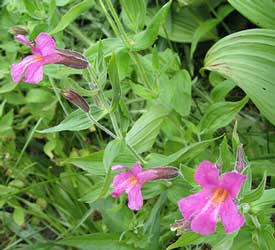 |
- Placement in a steam bath to ease chest and back soreness
- Mashing the leaves and applying it to wounds
- Steeping it in tea to ease stomach pain
- And just plain old eating it (although monkey flowers are rumored to have a bitter taste)
Interesting fact: In the early 1800s, monkey flowers were introduced to Europe in hopes of becoming an addition to personal gardens.
More Wildflower Identification Information
Yellow Wildflowers – Bust out the photos and identify a yellow wildflower
Purple Wildflowers – Tons of Glacier National Park’s wildflowers are purple. Discover identification tips for purple wild flowers
Orange Wildflowers – Though rare, orange wildflowers exist. Learn how to identify an orange wildflower
Indian Paintbrush – All about identifying the Indian Paintbrush Wildflower, one of Glacier National Park’s more magnificent flowers.
Spotting Wildflowers – Learn which Glacier National Park hiking trails are prime for spotting wildflowers on.
Bitterroot – Discover the Bitterroot, Montana’s state flower
Return home from
Wildflower Identification to the Glacier National Park Travel Guide











Speak Your Mind